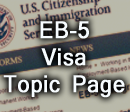Many people think that the only way to buy your way into legal presence in the United States is through the EB-5 (immigrant investor) program. Not so.
There are three different ways that an alien can buy his or her way into legal status; each pathway has a different price, sometimes involving more than just money; and each pathway has its own advantages and disadvantages. Here is a summary, more or less in the style of Consumer Reports, for the three routes to buy legal status:
| | |||
| Visa | Approximate Dollar Cost | Rewards to Alien and Family | Potential Complications |
| EB-5 (immigrant investor) | $500,000 for the entire family | After two years, if all goes well, a full set of green cards for the entire family; in the meantime, job permits for all. The alien is not required to do anything but put up the money. The ceiling is 10,000 visas. | This is a two-stage process, first: conditional resident status, then the green card; the whole business is awkward, and the program may also run into a statutory ceiling which will delay visas to the Chinese investors who dominate the program. Further, stateside crooks are sometimes a menace. |
| E-1 and E-2 (treaty trader and treaty investor) | At least $50,000 per family, often more | Easily renewable nonimmigrant visas allowing employment for parents and children under 21. Alien must run a business. No ceiling on visas. | The alien has to return to the home country every few years to renew the visa; after a while the under-21 children of the investors "age out" of the program. |
| Master's program sequence, starting with an F-1 and then an OPT visa | $50,000 and up for the individual alien, and more for MBAs | If the alien can secure the degree, and if the alien can get a series of jobs in the U.S., the alien can use F-1 (OPT) and H1-B visas on the way to a green card. Ceilings on both H-1B and green card visas. | Even if hired as an OPT (see text below) the alien may not get either an H-1B job or a green card; thus those with lower skill levels are running a risk. |

The EB-5 program has been described frequently in these pages and in the mainstream media, but less attention has been paid to the two other visa-buying techniques shown in the table.
The E non-immigrant visas fall into two categories, E-1 for treaty traders, essentially sales representatives for foreign corporations, and E-2 treaty investors, aliens who invest in, and run their own businesses in the United States. These are based on bi-national treaties and it so happens that while Chinese nationals dominate the EB-5 program, they are not eligible for either of the E programs because there is no U.S.-China treaty on this subject.
The State Department, alone, makes decisions about who is qualified for E visas, there are no numerical limits on the visas to be issued, and there are no published minimum investment levels required in the program, though $50,000 is often discussed as a threshold for treaty investors. Much more attention should be paid to this program, but it is hard to examine given that most of the decisions are made overseas by individual consular officers, and there is no public appeals process, as there is in the EB-5 program, where some interesting cases (such as the one involving the Watergate Hotel create intriguing public records).
There is one remarkable difference between the EB-5 and the E-2 programs, in favor of the latter; while most EB-5 aliens are passive investors, those in the E-2 class actually run businesses, or claim that they are planning to do so.
The master's program sequence, summarized in the table above, is not a government- prescribed program for buying visas, as the other two are; it is a somewhat tortuous path through various visa programs that many aliens from well-to-do alien families have discovered and used, but not always successfully.
In the course of my spring-time volunteer activity, involving helping graduate students with their income tax returns at a major DC-area university, I often talk with international students, some of whom are following this sequence. Most of the people I talk to are from either China or India. The sequence can work like this:
The student secures a bachelor's degree in one of the STEM fields (science, technology, engineering, math), usually overseas; he (they are usually males), then applies to a U.S. university for a master's degree in one of the STEM fields, often in computer sciences.
A two-year STEM master's degree costs about $30,000 - $40,000 in tuition, plus living expenses of, say, another $20,000. The tuition for MBA degrees, also used in this sequence, is usually higher. These costs can be paid by the alien (if he has some work experience and savings), but usually are met by his family. These are up-front costs with no guarantees, but apparently are regarded as a good investment by many prosperous Asian families.
In visa terms, the alien student arrives with an F-1 (foreign student) visa; after he gets his degree he can use an extension of that visa, called Optional Practical Training (OPT), to keep working in the United States, in a STEM field for an additional 29 months, as I have described in an earlier blog.
In terms of the alien's long-term prospects, a crucial test comes in the summer between the two academic years, when he either gets a summer job with a major company, or he does not, and he shines in that job, or does not. If he succeeds with both, he is more likely to get a job after graduation.
The student's objective, as graduation approaches, is to: 1) get a high-tech job with a U.S. corporation as an OPT visa holder, seeking a promise that 2) the employer will sponsor him for an H-1B assignment. Once he has an H-1B his next objective is 3) to have the employer sponsor him for a green card. Some move directly from graduate school into an H-1B position.
This, by definition, is a tension-laden situation for the worker (but not the employer). Someone whose parents have put up $50,000 or so may not get an OPT job at all; or after getting such a job, they are not sponsored for the H-1B; or after getting the H-1B may not land a green card.
It is, in short, both a risky enterprise for the alien and it places him in a form of indenture throughout both the OPT and the H-1B periods, and thus he tries to be a model worker. You can see why employers love this sequence!
A majority of the 20 or so people about to get master's degrees I talked with this year (admittedly a small and non-random sample) who are hoping to go into this sequence had not secured jobs two months before graduation; those who had (these are all in computer sciences) had accepted offers in the $85,000 - $100,000 a year range. One outstanding student, who apparently really scored in his summer job, turned down a $125,000 offer as an OPT worker with his previous employer to take a more interesting $100,000 job with another employer.
So the stakes are high in the master's sequence, but virtually no aliens enter it, unless someone puts up $50,000 or so. I have not run into any international graduate student who is operating on U.S.-based student loans; they do not seem to be available. Their families, of course, may have borrowed overseas.
Meanwhile, at the university where I volunteer, foreign students in PhD programs are usually funded by U.S. sources (usually through the university) and they rarely report family payments of tuition; they are destined for a much longer haul in academia (often five years) and not so spectacular salaries at the end of it. They are also much more likely to get better on-campus jobs, as teaching or research assistants, than the master's students.
The oft-discussed "staple" bills that would automatically give green cards to foreign students with advanced U.S. degrees would have a greater impact on the master's students (saving them the OPT and H-1B travails) than on the far fewer PhD students who tend to stay in the United States anyway under current laws as ongoing studies at Oak Ridge National Laboratory have shown repeatedly.
To summarize, these are the three ways to buy a visa (or a set of them):
With the EB-5 program there are no risks based on the behavior or the skills of the applicants, it just takes money, but there may be other complications; in the E-2 program, one must run a reasonably successful business to keep renewing one's nonimmigrant visa; and in the master's sequence, one has to please an employer through the various OPT, H-1B, and green card steps.
And all require at least $50,000 to enter the game.


